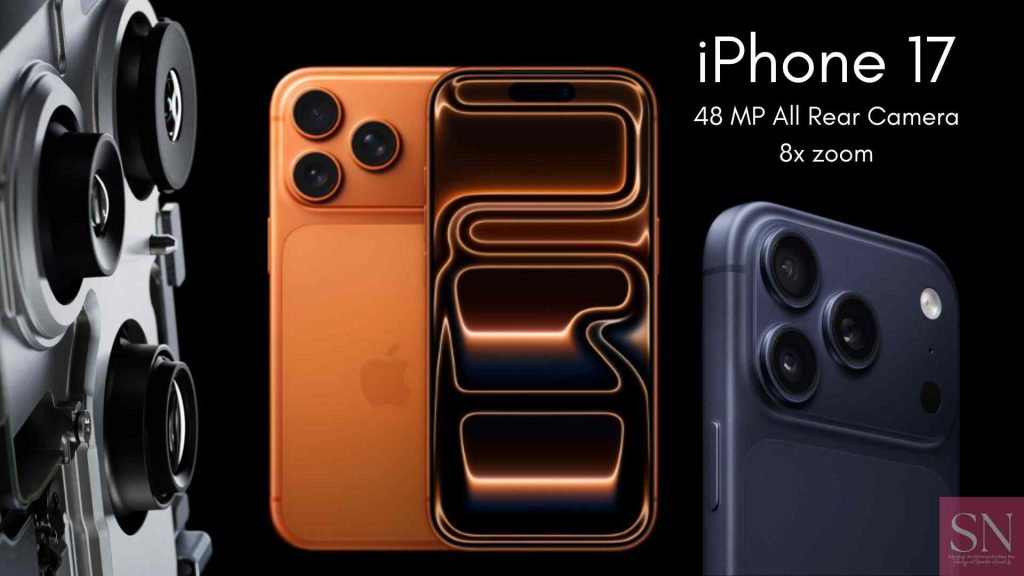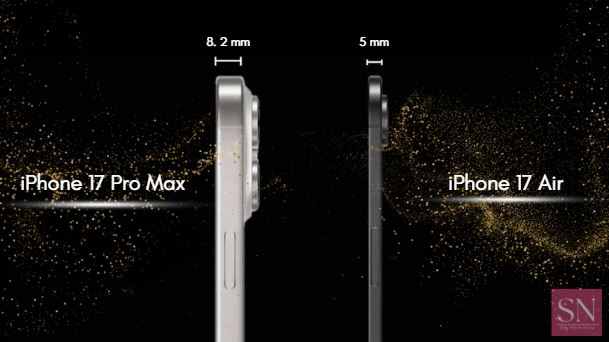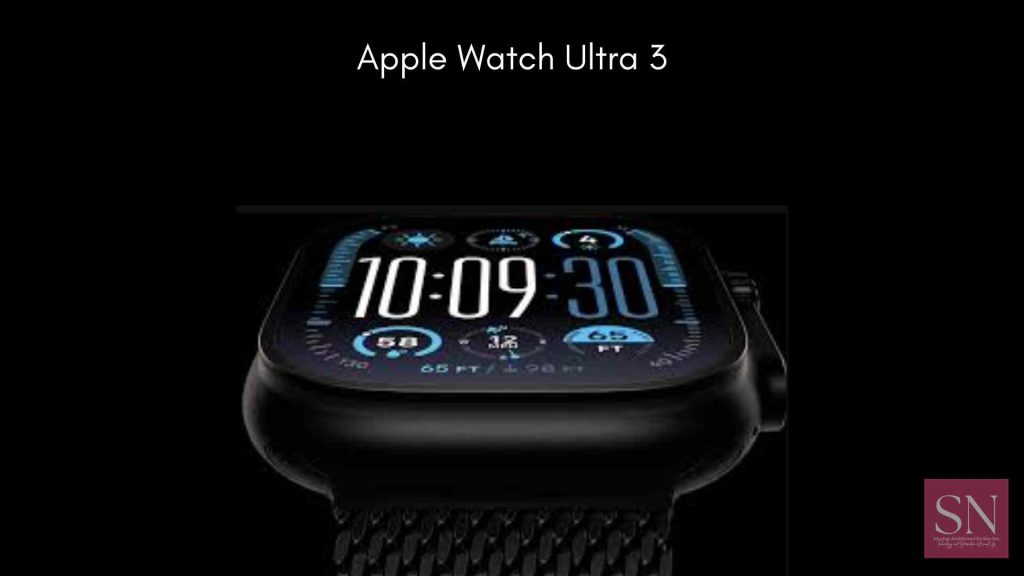
The iPhone 17 price in the US and global markets is highly anticipated for its launch. Apple is preparing for the September 9 ‘Awe Dropping’ event, which will be the debut stage for the iPhone 17 series along with several new devices. As the event approaches, speculation about the price of the iPhone 17 is beginning to emerge, especially in the United States, which is often used as a benchmark for global pricing. However, in reality, prices in each country can vary widely due to local taxes and international trade policies.

Estimated Prices for the iPhone 17 Series in the United States
According to J.P. Morgan analyst, Samik Chatterjee (via 9to5Mac), the latest lineup will be available in four models:
- iPhone 17 → starts at $799, the same as the iPhone 16.
- The iPhone 17 Air → expected to be priced between $899 and $949, which is about a $50 increase from the iPhone 16 Plus.
- The price of the iPhone 17 Pro → estimated at $1,099, it is clear that for this series release there is a $100 increase compared to the iPhone 16 Pro.
- As for the iPhone 17 Pro Max → it will stay at $1,199, the same as the previous generation.
The most significant change is in the iPhone 17 Pro, which now starts its base variant from 256GB of storage, instead of 128GB. With this strategy, Apple seems to not only be raising prices but also shifting the value of its product.
Price Consistency of iPhone in the US
Historically, Apple has kept iPhone prices pretty steady in the US. Both the iPhone 15 and iPhone 16 series were released with identical starting prices at: $799 for the base model, $899 for the Plus, $999 for the Pro, and $1,199 for the Pro Max. This creates the expectation that Apple is striving to maintain price stability in its domestic market, even though it often varies significantly in other countries.
Why Are iPhone Prices Different in Every Country?
The main factors affecting global prices are import tariffs and tax policies. Since the Trump administration, import tariffs on electronic products from China—where most iPhones are assembled—have sharply increased. Countries that do not have specific trade agreements with the US or China ultimately have to bear the burden of higher tariffs, which is directly reflected in the selling price of the iPhone.
A clear example was seen in India last year, where the base model iPhone 16 was priced at the equivalent of Rs. 79,900, much more expensive compared to the US price. A similar phenomenon also occurred in various Asian countries, including Indonesia and Singapore, although with different percentage variations in taxes.
Price Comparison Simulation for iPhone 17
Here is an estimate of the price comparison for the standard iPhone 17 in several countries, taking into account the average applicable taxes and import duties:
| Country | Base Price (US$) | Import/Tax Rate | Estimated Retail Price | Notes |
|---|---|---|---|---|
| United States | $799 | 0% (reference price) | $799 | Official US retail price, global benchmark |
| China | $799 | ~15% | $919 | Higher tariffs due to trade tensions |
| Singapore | $799 | 7% GST | $855 | Relatively low consumption tax |
| Indonesia | $799 | ~20% (VAT+import duty) | $959 | One of the highest-taxeed iPhone markets |
Why iPhone 17 Prices Differ by Country
- United States → Apple’s home market, no import duty applied. Prices here set the global benchmark.
- China → Assembly hub but still subject to U.S.–China trade tariffs introduced during Trump’s administration, which continue to affect electronics imports.
- Singapore → Known for its relatively low 7% GST, making iPhones more affordable compared to neighbors.
- Indonesia → High VAT and import duties push prices up significantly, making it one of the most expensive markets for iPhones in Southeast Asia.
Apple September 9 Event: More Than Just an iPhone
Along with the iPhone 17, Apple is anticipated to unveil as many as seven new products, including the super-slim iPhone 17 Air, which is said to be taking over the iPhone Plus line. Other products, such as the Apple Watch and AirPods, will also receive significant updates, particularly in health features.
This event comes at an important moment for Apple. Despite facing pressure in the artificial intelligence (AI) sector and a stock decline of around 15-19% throughout 2025, the company continues to show financial resilience. iPhone revenue actually surged 13.5% in the third quarter to $44.6 billion, largely due to consumers upgrading before potential tariff increases take effect.
Furthermore, Apple is also preparing the Liquid Glass design language, a new visual system that recalls iOS 7 but focuses more on depth and transparency, inspired by Vision Pro. This design will serve as the foundation of Apple’s transformation strategy over the next three years, while also unifying aesthetics across devices towards the era of spatial computing.
The First iPhone “Air”: Apple’s Most Daring Redesign in Years
One of the main highlights of Apple’s September 9 event is the arrival of the iPhone 17 Air — the first iPhone to carry the name “Air,” a nickname that soared through the MacBook line two decades ago. This ultrathin model is projected to replace the iPhone Plus series, which has underperformed in the global market.
With a thickness of only 5.5mm at its thinnest point, the iPhone 17 Air is significantly slimmer than the iPhone 16, which has a profile of 7.8mm. This claim makes it a strong contender for the thinnest iPhone in history.
iPhone 17 Air: Design and Features

- Display: 6.6-inch with 120Hz ProMotion support — for the first time this feature is available in the non-Pro lineup.
- Build: produced with a hybrid frame made of titanium and aluminum, weighing only 145 grams, making it much lighter compared to the iPhone 16 Pro which weighs 199 grams.
- Camera: One 48MP rear camera, accompanied by a compromise on the smaller battery.
- Other Changes: The USB-C port has been slightly moved from the center, and the speaker grille has been simplified to keep a sleek look.
- Colors: Black, White, Light Gold, and Light Blue (similar to MacBook Air).
- Price: It’s expected to kick off at $899, which is the same as the current iPhone Plus.
iPhone 17 and iPhone 17 Pro
Along with the launch of the iPhone 17 Air, Apple has released a major update for the standard and Pro models.

- iPhone 17 (Standard): 24MP front camera, twice the size of the current model. Each iPhone 17 model will come equipped with ProMotion 120Hz display features.
- iPhone 17 Pro & Pro Max:
- New design with pill-shaped camera bump.
- 48MP telephoto camera with 8x optical zoom (up from 5x on the iPhone 16 Pro).
- The aluminum back is replacing the glass, making it tougher and lighter.
- New colors Orange and Blue, in addition to classic options Black, White, and Silver.
- Rumors also mention a vapor chamber cooling system to reduce heat during heavy usage.
Apple Watch Series 11: Health at the Core

The Apple Watch Series 11 is rumored to bring health innovations, with a blood-pressure trend tracking feature that can detect hypertension patterns even though it does not yet display complete systolic-diastolic readings.
This watch will use the new S11 chip, which is smaller allowing for more space for a larger battery or additional sensors. The RedCap 5G connection is also expected to be present, enhancing data speed from previous LTE models.
Apple Watch Ultra 3: Connectivity Without Limits

Even more ambitious, the Apple Watch Ultra 3 is reported to be the first Apple Watch with stand-alone satellite connectivity. This means that users can access emergency SOS features and even send text messages in areas without cellular or Wi-Fi coverage.
Other awaited features:
- Larger and brighter screen, with better viewing angles.
- Faster 5G connectivity.
- New fast charging coil capable of charging up to 80% in just 30 minutes.
AirPods Pro 3: Health and Smarter Audio

Not just the iPhone and Apple Watch, but Apple is also gearing up to launch the AirPods Pro 3. This third-generation model reportedly brings heart-rate monitoring with an LED optical sensor that detects blood flow in the ear canal.
In addition, other awaited improvements include:
- Improved Active Noise Cancellation to better block external sounds.
- Enhanced sound quality thanks to the new H3 audio chip.
- Potential features for temperature monitoring and even real time translation.
- A slimmer design with hidden LED status.
Apple’s Bigger Picture: The Road to 2027
More than just an annual release, this Awe Dropping event is the first step for Apple towards a three-year transformation — the most ambitious roadmap since the first iPhone.
- 2026 → Apple is expected to launch a foldable iPhone in a book style similar to the Samsung Galaxy Z Fold, featuring an inner screen of 7.8 inches and an outer screen of 5.5 inches. Rumors suggest that the price of the series to be launched is around $2,000, making it the most expensive iPhone ever.
- 2027 → Apple is preparing the “iPhone 20,” with an all-glass curved design without bezels or notches. This design is completely integrated with a Liquid Glass interface in iOS 26, focusing on transparency, depth, and elements of spatial computing.
- AR Glasses → CEO Tim Cook has made smart AR glasses a major focus, aiming for a release in 2027. This product is projected to complement the evolution of the Vision Pro, which will come in various versions, including the lightweight Vision Air model (up to 40% lighter) in 2027.
- Ecosystem Expansion → Apple aims to sell more than 10 million AR/VR devices per year by 2027, strengthening its position against Meta and Google.
Event Timeline: What to Expect
Apple will broadcast the Awe Dropping event on Tuesday, September 9 through its official website, YouTube, and Apple TV. Based on previous years’ patterns:
- Preorders: will open starting Friday, September 12.
- General availability: the initial launch is expected on September 19 for several iPhone 17 models.
Is the iPhone 17 Worth It?
The launch of the iPhone 17 series is clearly not just about a new device, but rather Apple’s strategy to maintain its position amid the intense competition in the technology industry. The relatively stable prices in the US convey a sense of consistency, but in reality, consumers abroad, including in Indonesia, have to bear higher costs due to import tariffs and taxes.
For markets like Singapore, the price increase remains moderate due to low taxes. However, in Indonesia, a tax burden of around 20% makes the iPhone 17 potentially sell for almost $160 more than the official price in the US. This often leads to a dilemma: is buying in Indonesia still worth it, or is it better to purchase it abroad?
Nonetheless, Apple’s appeal remains strong. From the ultrathin design of the iPhone 17 Air, the Pro model with 8x zoom, to the ecosystem bolstered by the new generation of Apple Watch and AirPods, Apple continues to offer unmatched value. Additionally, the long-term goal of a foldable iPhone and AR glasses shows that Apple is laying the groundwork for the next decade of tech.
For Indonesian users, the final decision will depend on their priorities:
- If they want the latest technology with solid ecosystem integration, the iPhone 17 is still a worthwhile option despite being more expensive.
- However, for those sensitive to prices, waiting for the official launch or buying through alternative channels like abroad can be a more rational option.
One thing is for sure, the Awe Dropping event 2025 is not just about the new iPhone, but also about how Apple redefines the future of smart devices — from smartphones to mixed reality.
Frequently Asked Questions (FAQ)
How much will the iPhone 17 cost in the US?
The starting price for the base iPhone 17 is anticipated to be $799 in the U.S., while the iPhone 17 Air is likely to be around $899, the iPhone 17 Pro price will be at $1,099, and the iPhone 17 Pro Max price prediction at $1,199.
Why are iPhone 17 prices different in other countries?
Prices vary because of import tariffs, VAT, and local taxes. For example, China faces higher tariffs due to trade policies, while Indonesia applies one of the highest combined VAT and import duties in Southeast Asia. Singapore, on the other hand, has relatively low GST, making iPhones more affordable.
What makes the iPhone 17 Air different from previous models?
The iPhone 17 Air is Apple’s first super-slim iPhone, coming in at just 5.5mm at its thinnest point. It features a 6.6-inch 120Hz ProMotion display, a lightweight titanium-aluminum frame, and a sleeker overall design. However, it comes with some compromises such as a smaller battery and a single rear camera.
Will all iPhone 17 models support ProMotion?
Yes. For the first time, all iPhone 17 models—including the standard version—are expected to feature 120Hz ProMotion displays, a feature previously limited to Pro models.
When can I preorder the iPhone 17?
Apple is expected to open preorders on September 12, 2025, following its September 9 launch event. General availability is projected to begin on September 19, 2025, starting with select markets like the US.
Is the iPhone 17 worth upgrading to?
If you value thinner design, smoother displays, and camera upgrades (especially on the Pro models), the iPhone 17 is a solid upgrade. However, if you live in a market with high import taxes, like Indonesia, the price difference compared to the US may make upgrading less appealing unless you purchase overseas.
What’s on the horizon for Apple after the iPhone 17?
Apple’s roadmap includes a foldable iPhone in 2026, a radical all-glass iPhone 20 in 2027, and AR glasses designed to integrate with its Vision Pro ecosystem. These upcoming products showcase Apple’s commitment to spatial computing and augmented reality.
For now, all eyes are on the iPhone 17 series and how global pricing will impact consumer adoption. While US buyers may enjoy relatively stable prices, international customers in markets like China, Singapore, and Indonesia will feel the effects of varying tariffs and local taxes. These differences highlight Apple’s ongoing challenge of balancing premium branding with accessible pricing in a competitive global market.
What’s Next?
Want to know interesting thing? Don’t miss our upcoming guide on “10 Ways to Earn Passive Income with AI in 2025”—perfect for anyone comparing features, prices, and long-term value before making the switch.


1 thought on “iPhone 17 Price in the US and Global Markets: Why Buyers May Pay More”